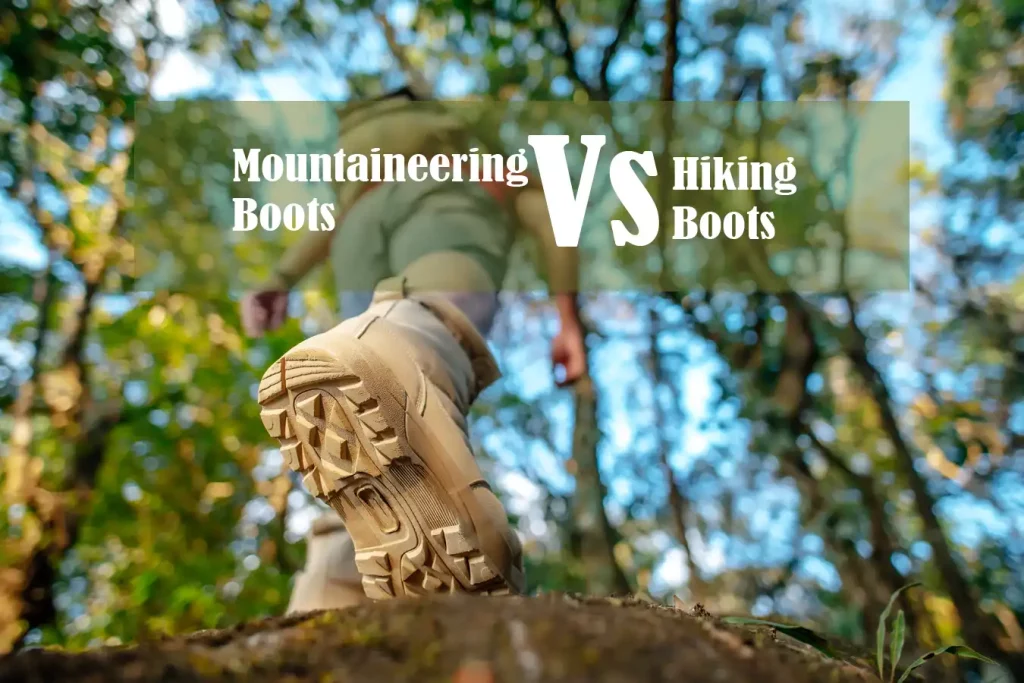Navigating the debate between mountaineering boots vs hiking boots can be as challenging as an alpine climb or a woodland trail.
I’ve treaded countless paths, both steep and smooth, in my years of outdoor adventures.
Ever been baffled about which footwear to choose for your next escapade?
This article aims to decode the nitty-gritty, ensuring you step out with confidence.
From the aroma of campfire smoke to the gentle hum of forest rain, I’ve cherished every moment outdoors, and I want to ensure your experiences are just as remarkable.
Get ready to embark on a journey of discovery, and by the end, you’ll know exactly which boot is the right fit for your next trek.
A Brief History of Outdoor Boots
Before we delve deep into the differences between mountaineering and hiking boots, it’s essential to appreciate where they came from. You know, the kind of stories they’d tell if they could speak. (Wishful thinking, I know!)
Evolution of Mountaineering Boots
Mountaineering boots have come a long way since their inception. Picture this: early adventurers taking on towering icy peaks with basic leather boots, feeling every jagged rock and cold gust. Fast forward to today, these boots have transformed.
Incorporating technological advances, today’s mountaineering boots are designed to withstand extreme temperatures, rough terrains, and provide ankle stability for those precarious ridge walks. It’s almost like witnessing a boot-version of ‘The Evolution of Man’.
The Journey of Hiking Boots through Time
Now, let’s talk about hiking boots. Unlike their mountaineering cousins, hiking boots weren’t always about tackling fierce environments. They were the casual strollers, built for comfort and daily jaunts through the woods.
But as the passion for hiking grew, so did the demand for sturdier, more durable boots. Today, these boots are not just about comfort. They are a beautiful blend of functionality and style, ready for both a walk in the park and a rigorous day-hike.
Hiking Boots
Ever found yourself ambling through the woods or trekking across trails, marveling at nature’s beauty? Well, the hiking boots on your feet were most likely your silent partners, providing comfort and support.
They are designed to be your best friends on the trails, offering just the right blend of comfort, durability, and style. So what makes them tick? Let’s find out!
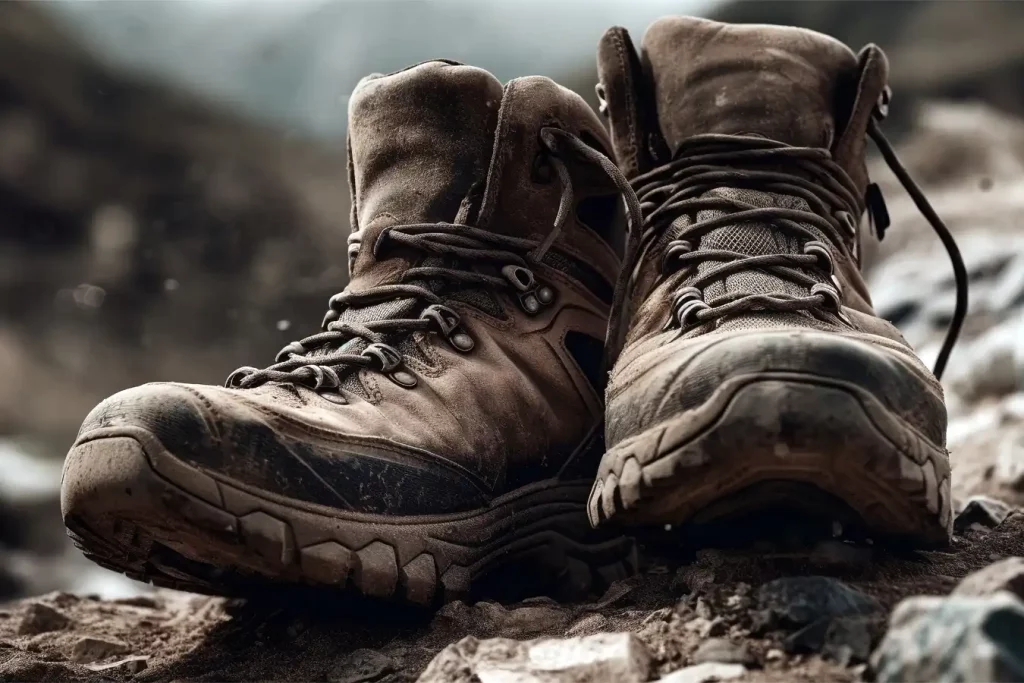
Features of Hiking Boots
Materials and Construction
The foundation of any good hiking boot lies in its materials and construction. Modern hiking boots are a blend of leather, synthetics, and sometimes even waterproof membranes.
They provide a balance between ruggedness and comfort, ensuring you can trudge through muddy trails without feeling a pinch!
Types of Hiking Boots
From lightweight trail shoes to backpacking boots, hiking boots come in various shapes and sizes. Choose a lightweight design for casual walks or something more robust for multi-day hikes. The variety ensures there’s a perfect fit for every foot and every adventure!
Ideal Terrains and Conditions
Whether it’s a dusty desert trail or a muddy forest path, hiking boots are designed to adapt. They provide stability on uneven ground and protection from the elements. The key here is to match the boot with your most frequented terrains.
Comfort and Fit
Cushioning and Support
You wouldn’t walk miles without the right cushioning, would you? Hiking boots offer specialized padding, arch support, and shock absorption features, ensuring every step is a pleasure.
Breathability
Hot, sweaty feet can quickly turn a pleasant hike into a nightmare. That’s why breathability is a must. Modern hiking boots come with breathable linings and materials to keep your feet fresh all day long.
Weight Considerations
Every ounce counts on a long hike. Fortunately, today’s hiking boots are built with weight in mind. Whether you prefer something feather-light or a boot with more heft, the choice is yours.
Technology and Innovations
Waterproofing
Imagine crossing a stream and not worrying about wet socks! Thanks to waterproofing technologies, that dream is now a reality.
Traction
Ever danced on a slippery trail? I hope not! Traction is crucial, and hiking boots are engineered with specialized soles to grip various surfaces.
Durability and Lifespan
Hiking boots are no flimsy affair. They are built to last, withstand wear and tear, and be your trusty companion for many a trail.
Mountaineering Boots
Mountaineering boots are to mountain climbers what a scalpel is to a surgeon. They’re specialized, precise, and critical for performance.
While hiking boots are designed for comfort and adaptability, mountaineering boots are built for strength, stability, and extreme conditions. Let’s unravel the magic behind these rugged boots.
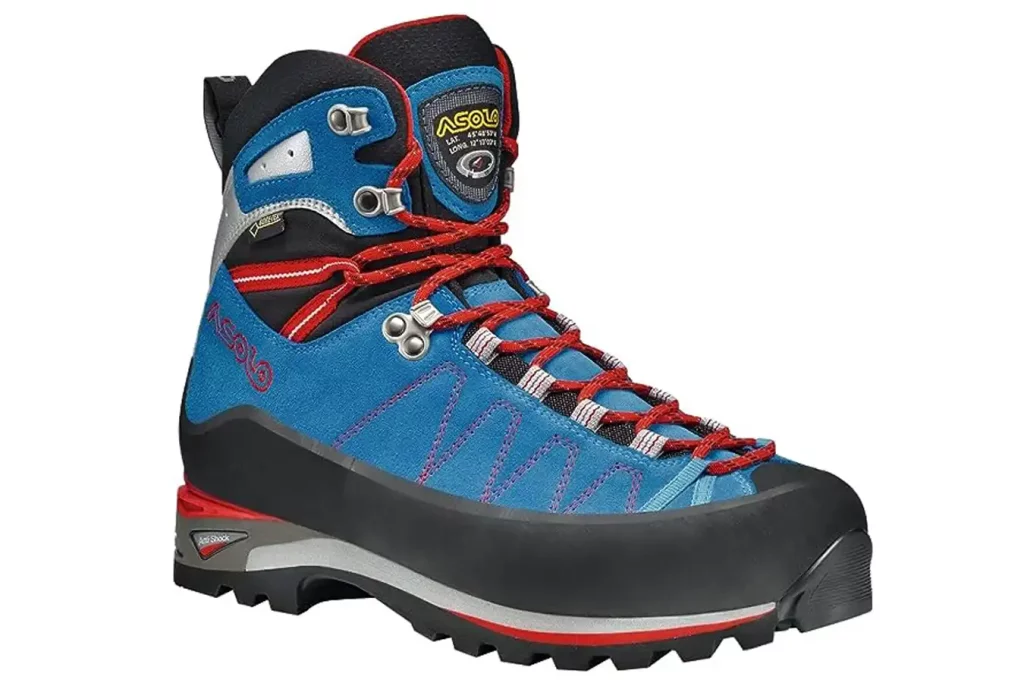
Features of Mountaineering Boots
Rigidity and Support
The stiffness in mountaineering boots isn’t a design flaw; it’s a lifeline! These boots provide the rigid support needed to climb steep ice and rock. The stiff sole ensures stability and offers better control during ascents.
Types of Mountaineering Boots
From single-layer boots for summer alpine climbs to double or even triple boots for extreme cold, the types vary based on your needs.
Remember, choosing the right type can mean the difference between a successful summit and a frostbitten toe!
Ideal Terrains and High-Altitude Considerations
These boots are designed for the harshest terrains and highest altitudes. They ensure that your feet stay insulated, protected, and functional, whether you’re climbing Kilimanjaro or Everest.
Performance and Efficiency
Ankle and Foot Stability
Think of it as a tight hug for your ankles. The support these boots provide ensures stability during precarious climbs and keeps those ankles safe.
Insulation for Extreme Conditions
Ever heard of the term “cold feet”? You won’t feel it in these boots. With specialized insulation layers, mountaineering boots keep your feet warm in temperatures that would make a polar bear shiver.
Compatibility with Crampons and Other Equipment
Climbing a steep icy slope? You’ll need crampons. Mountaineering boots are designed with built-in compatibility with these and other essential climbing tools.
Technology and Innovations
Layering Systems
The layering in these boots isn’t just for looks; it’s about warmth, comfort, and functionality. Each layer serves a purpose, ensuring your feet remain a happy part of your climbing team.
Advanced Materials
From carbon inserts for stiffness to synthetic insulation for warmth, the materials in mountaineering boots are a marvel of modern engineering.
High-Altitude Performance Enhancement
These boots aren’t just footwear; they’re part of a high-altitude performance system. They work in harmony with your gear, your body, and the mountain to help you reach that peak.
Mountaineering Boots vs Hiking Boots: A Comparative Analysis
So, you’ve come to that crucial point where you need to decide: mountaineering boots or hiking boots? While they may look similar to the untrained eye, these two types of boots serve very different purposes.
Let’s take a closer look and unravel the differences between these two essential outdoor companions.
Design and Structure: Mountaineering Boots vs Hiking Boots
Mountaineering boots are the rugged warriors of the mountain world. With thick, stiff soles and robust construction, they’re built for the challenging terrains of high peaks.
Hiking boots, on the other hand, emphasize flexibility and comfort, perfect for long treks on various trails.
Mountaineering Boots: Built for grip, stability, and extreme temperatures.
Hiking Boots: Designed for comfort, versatility, and more forgiving terrains.
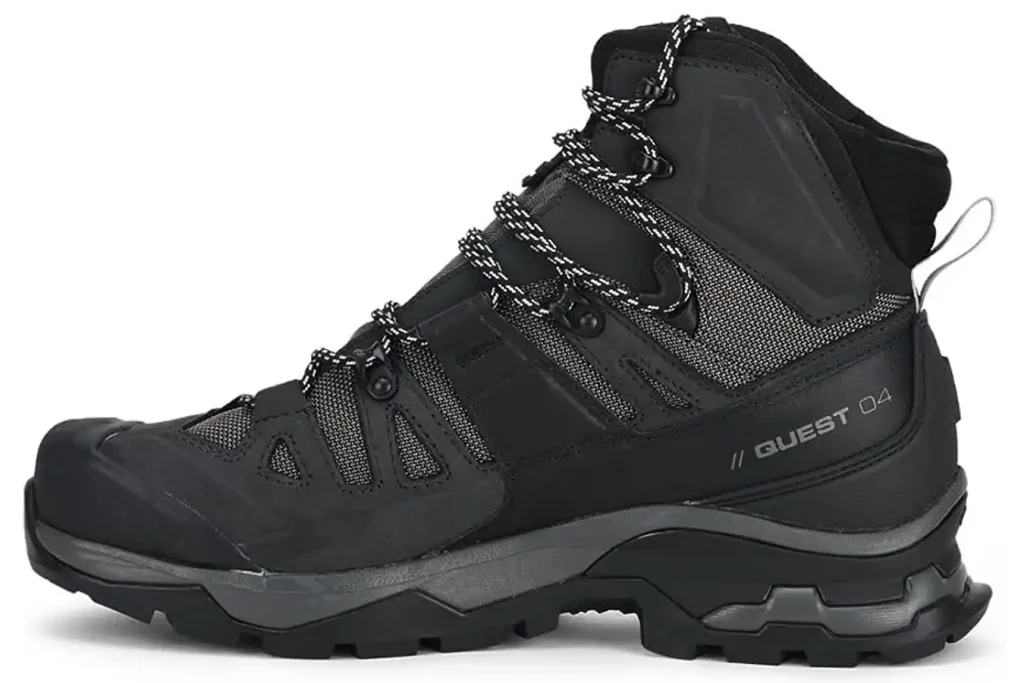
Weight and Comfort: Mountaineering Boots vs Hiking Boots
When it comes to weight, hiking boots often win the race. They’re lighter, allowing for longer and more comfortable treks.
Mountaineering Boots: Heavier due to insulation and rigidity, focusing on support rather than comfort.
Hiking Boots: Lighter, with cushioning and support designed to keep you comfortable on long hikes.
Durability and Longevity: Mountaineering Boots vs Hiking Boots
Both types of boots are built to last, but the demands placed on them are different.
Mountaineering Boots: Made to withstand harsh conditions, these boots are often more durable but might require special care.
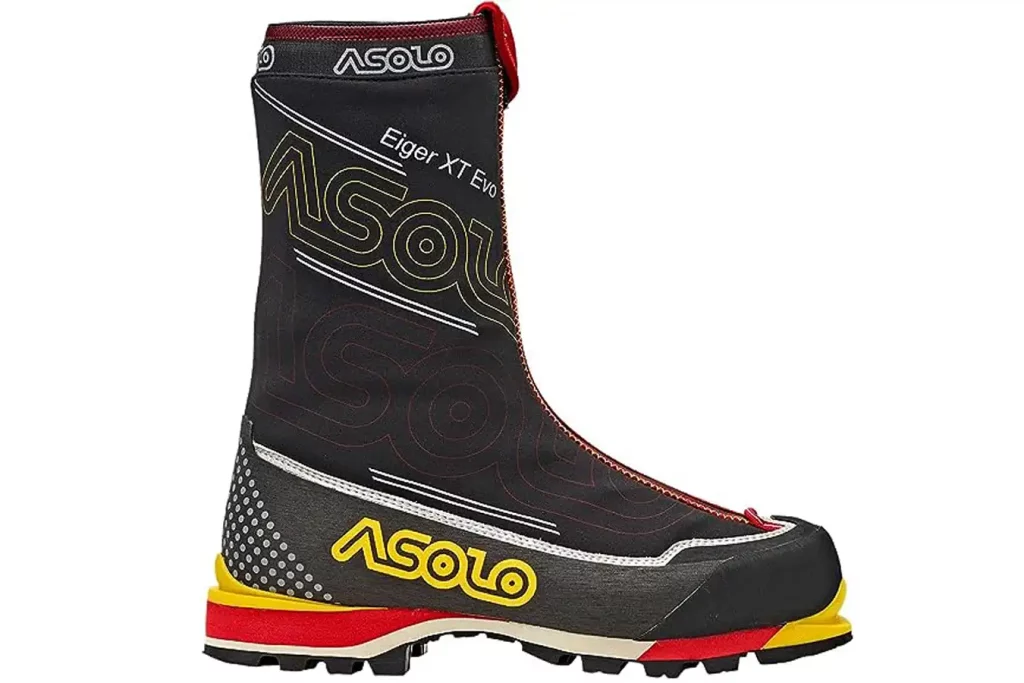
Hiking Boots: While strong, they might wear out faster when used in extreme conditions meant for mountaineering boots.
Traction and Support: Mountaineering Boots vs Hiking Boots
The difference in traction and support is like comparing a tractor to a road car. Both are efficient in their respective fields.
Mountaineering Boots: Enhanced traction for ice and rock, with rigid support for climbing.
Hiking Boots: Flexible support for various terrains but not ideal for extreme climbing conditions.
Weather Resistance: Mountaineering Boots vs Hiking Boots
Here’s where the real battle begins.
Mountaineering Boots: Waterproof, windproof, and insulated against the most severe weather.
Hiking Boots: Often weather-resistant but might not stand up to the intense cold of high altitudes.
In short, the comparison between mountaineering boots and hiking boots:
| Features | Mountaineering Boots | Hiking Boots |
| Design and Structure | Rigid, for extreme conditions | Flexible, for diverse terrains |
| Weight and Comfort | Heavier, with insulation | Lightweight, prioritizing comfort |
| Durability and Longevity | Highly durable | Lasting but less extreme |
| Traction and Support | Superior on ice and rocks | Excellent on various terrains |
| Weather Resistance | Extreme weather, sub-zero temps | Versatile, not for extreme cold |
Learn more: Hiking Boots Vs Work Boots
Ethical Considerations
In the world of outdoor adventure, the choice of footwear is not only about comfort, durability, and functionality. There’s also an underlying ethical consideration that often gets overlooked.
From the environmental impact to sustainability, the boots you choose can reflect your values and commitment to our planet.
Environmental Impact
The production of both mountaineering and hiking boots can have various effects on the environment. The energy consumption, waste generation, and resource depletion are just some aspects to consider.
Mountaineering Boots: Often use more materials and complex construction, leading to a potentially higher environmental footprint.
Hiking Boots: Typically lighter and may use fewer resources, but the impact can vary significantly between brands and models.
Materials and Sustainability
Sustainability has become a buzzword, but it’s a crucial aspect to consider in the choice of outdoor gear.
Mountaineering Boots: May use specialized materials that can be less sustainable. However, some brands focus on using recycled or environmentally-friendly components.
Hiking Boots: Often offer more options for sustainable materials, such as vegan or recycled products.
Recycling and Disposal Options
The end of the life cycle for any product is essential, and outdoor boots are no exception.
Mountaineering Boots: Can be more challenging to recycle due to the complexity of materials.
Hiking Boots: Might offer easier recycling options, but it depends on the specific design and materials used.
In a world striving for more conscious living, your choice of boots can be a statement of your commitment to sustainability and responsible consumption.
FAQs
What is special about mountaineering boots?
What are mountaineering boots?
What is the difference between hiking boots and trekking boots?
Are walking boots and hiking boots the same?
Conclusion
Whether you’re scaling the heights of Everest or wandering through your local trails, the decision between mountaineering boots and hiking boots is a significant one. It’s not just about your comfort, your safety, or even the thrill of adventure; it’s a choice that reflects your values and impacts the world around you.
So what’s the takeaway here? It’s that your feet are more powerful than you think! They lead you on adventures, but they also walk the path of ethical consideration.
What next? Dive into research, explore brands that align with your values, and don’t be afraid to ask questions. The perfect pair of boots is not just about fit and function; it’s about being part of a global community that cares.
Ready to lace up and make a difference? Your next adventure is waiting, and the choice is yours. Make it a good one!
Also learn: Snow Boots Vs Hiking Boots

